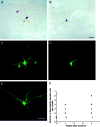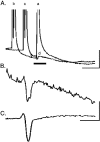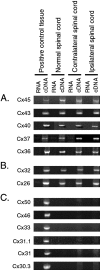Nerve injury induces gap junctional coupling among axotomized adult motor neurons
- PMID: 10632597
- PMCID: PMC6772393
- DOI: 10.1523/JNEUROSCI.20-02-00674.2000
Nerve injury induces gap junctional coupling among axotomized adult motor neurons
Abstract
Neonatal spinal motor neurons are electrically and dye-coupled by gap junctions, but coupling is transient and disappears rapidly after birth. Here we report that adult motor neurons become recoupled by gap junctions after peripheral nerve injury. One and 4-6 weeks after nerve cut, clusters of dye-coupled motor neurons were observed among axotomized, but not control, lumbar spinal motor neurons in adult cats. Electrical coupling was not apparent, probably because of the electrotonic distance between dendrodendritic gap junctions and the somatic recording location. Analyses of gap junction protein expression in cat and rat showed that the repertoire of connexins expressed by normal adult motor neurons, Cx36, Cx37, Cx40, Cx43, and Cx45, was unchanged after axotomy. Our results suggest that the reestablishment of gap junctional coupling among axotomized adult motor neurons may occur by modulation of existing gap junction proteins that are constitutively expressed by motor neurons. After injury, interneuronal gap junctional coupling may mediate signaling that maintains the viability of axotomized motor neurons until synaptic connections are reestablished within their targets.
Figures





Similar articles
-
Gap junctional coupling and patterns of connexin expression among neonatal rat lumbar spinal motor neurons.J Neurosci. 1999 Dec 15;19(24):10813-28. doi: 10.1523/JNEUROSCI.19-24-10813.1999. J Neurosci. 1999. PMID: 10594064 Free PMC article.
-
Gap junctional communication among developing and injured motor neurons.Brain Res Brain Res Rev. 2000 Apr;32(1):242-9. doi: 10.1016/s0165-0173(99)00085-5. Brain Res Brain Res Rev. 2000. PMID: 10751674 Review.
-
Re-evaluation of connexins associated with motoneurons in rodent spinal cord, sexually dimorphic motor nuclei and trigeminal motor nucleus.Eur J Neurosci. 2014 Mar;39(5):757-70. doi: 10.1111/ejn.12450. Epub 2013 Dec 9. Eur J Neurosci. 2014. PMID: 24313680 Free PMC article.
-
Reduced gap junctional coupling leads to uncorrelated motor neuron firing and precocious neuromuscular synapse elimination.Proc Natl Acad Sci U S A. 2007 Jul 10;104(28):11808-13. doi: 10.1073/pnas.0703357104. Epub 2007 Jul 3. Proc Natl Acad Sci U S A. 2007. PMID: 17609378 Free PMC article.
-
Electrical synapses in the mammalian brain.Annu Rev Neurosci. 2004;27:393-418. doi: 10.1146/annurev.neuro.26.041002.131128. Annu Rev Neurosci. 2004. PMID: 15217338 Review.
Cited by
-
Asymmetric Dimethylarginine Protects Neurons from Oxygen Glucose Deprivation Insult by Modulating Connexin-36 Expression.Oxid Med Cell Longev. 2022 Jul 6;2022:5339361. doi: 10.1155/2022/5339361. eCollection 2022. Oxid Med Cell Longev. 2022. Retraction in: Oxid Med Cell Longev. 2024 Jan 9;2024:9785874. doi: 10.1155/2024/9785874. PMID: 35847590 Free PMC article. Retracted.
-
Gap junctions, pannexins and pain.Neurosci Lett. 2019 Mar 16;695:46-52. doi: 10.1016/j.neulet.2017.06.035. Epub 2017 Jun 22. Neurosci Lett. 2019. PMID: 28647288 Free PMC article. Review.
-
The onset of hyperreflexia in the rat following complete spinal cord transection.Spinal Cord. 2008 Dec;46(12):798-803. doi: 10.1038/sc.2008.49. Epub 2008 Jun 10. Spinal Cord. 2008. PMID: 18542097 Free PMC article.
-
Regulation and restoration of motoneuronal synaptic transmission during neuromuscular regeneration in the pulmonate snail Helisoma trivolvis.Biol Bull. 2011 Aug;221(1):110-25. doi: 10.1086/BBLv221n1p110. Biol Bull. 2011. PMID: 21876114 Free PMC article.
-
Neuronal gap junctions are required for NMDA receptor-mediated excitotoxicity: implications in ischemic stroke.J Neurophysiol. 2010 Dec;104(6):3551-6. doi: 10.1152/jn.00656.2010. Epub 2010 Oct 13. J Neurophysiol. 2010. PMID: 20943940 Free PMC article.
References
-
- Aldskogius H, Kozlova EN. Central neuron–glial and glial–glial interactions following axon injury. Prog Neurobiol. 1998;55:1–26. - PubMed
-
- Balice-Gordon RJ, Pereda A, Pinter MJ. Functional gap junctions couple motor neurons in development and reinnervation. Soc Neurosci Abstr. 1996;22:1487.
Publication types
MeSH terms
Substances
Grants and funding
LinkOut - more resources
Full Text Sources
Miscellaneous
